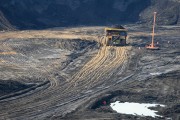After a year that has seen world markets shaken by scandals and dubious accounting practices, it is no surprise to learn that the investment community now wants to know more about the liabilities around oilsands investments. Lines in the Sands: Oilsands Sector Benchmarking, a report released this week by Northwest & Ethical Investments L.P., gives investors a way to begin to compare the risks associated with publicly-traded oilsands companies.
The report draws on a questionnaire and publicly available documents to compare the policies of 13 oilsands companies, rating them in relation to risks to their operations. Lines in the Sand found that the majority of disclosed material was presented in a way to prevent a thorough analysis. Very few companies shared the risk of Aboriginal rights litigation, for example, and only one company offered absolute carbon emission reduction targets. Despite most companies acknowledging the importance of water conservation, less than a quarter disclosed any water management targets. Land reclamation reporting was also poor across the board, and no company was willing to report the reclamation cost estimates for their tailing ponds.
Nearly two years after our first oilsands report card, Under-mining the Environment, Northwest & Ethical Investments shared similar frustrations over the lack of disclosure among oilsands companies. The information provided to shareholders, the government and the broader public does not present a full picture of oilsands impacts. While the industry bemoans the fact that it can't get its message out, it obscures the very data that would enable reasonable discussion around oilsands development.
With my work at the Pembina Institute, I often encounter the same frustrations and roadblocks in obtaining meaningful environmental data. In early 2010, we will be releasing a report card that ranks environmental performance of in situ oilsands operators. I am disappointed to say that only three of the seven operations have been willing to provide information to us about their operations. We have had to do a lot of digging to compare environmental performance.
Lines in the Sands is a great read for anyone interested in seeing the kind of exposure that oilsands operators face as the investment community grows increasingly sensitive to environmental and social issues. While there are many ways to influence oilsands policy, targeting the investment capital of oilsands operators is becoming a much more common strategy. Investors are quite rightly demanding to know more about the risks they face, and Ceres — a network of investors representing more than $9 trillion US in assets, and one of the commissioners of Lines in the Sand — is not a group to be taken lightly.









